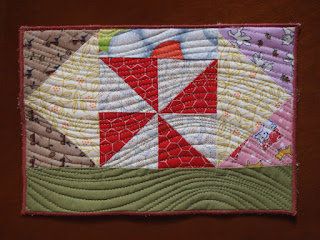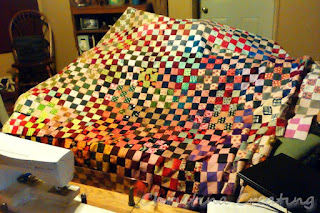So we picked a day and my two mothers-in-law and I headed to Hamilton, Missouri, also known as Quiltville USA.
Why the fuss? Why all the excitement? Well MSQC has become quite a thing in the quilting world. The owner, Jenny, puts out great videos on youtube every week and they have made themselves known for selling precut packages (especially online).
It all started when Jenny's kids were worried she wouldn't have anything to do when they all left the house. So they bought her a longarm quilting machine, you know, to keep her busy. They had no room for it in their house so they bought an empty building in the town to house it. (I believe it was the old library.) The building cost less than the quilting machine did.
From professional longarm quilting, she moved into selling fabrics and long story short, a lot of the family is involved in running this big business that now owns about eight store fronts in town. (That's about half of downtown Hamilton.) The company also has a conference center where they host classes and overnight retreats.
And that has spawned a whole local economy centered on quilters. There are B&Bs for groups that plan quilting retreats there so they can be close for shopping. All of them advertise having a large room where you can quilt while you stay there.
The company also has packages for buses full of quilters that come from all over. Anyway, all that is to say it has become a destination spot. (Hamilton is also the hometown of JC Penny, but that's not quite as big a draw.)
We had a lovely time perusing all the shops. They have them organized by type of fabric (like moderns, juvenile, licensed prints, batiks, reproductions, etc.).
 |
| Here we are in the main store. |
I found a charm pack (5" squares) in soft red, cream and blue (left side of picture):
and then found the three pieces of yardage (on the right) that could go with them. What will this be? I have no project in mind at this time but sometimes the fabric comes before the pattern.
Here are some more precut packages I took home:
Two shibori packs (left), a mini charm (2.5" squares) of light neutrals, a layer cake (10" squares, on right) of various neutrals with text, numbers, music or map motifs, and a charm back (bottom middle) of more blue and white fabric which have the look of Delft blue pottery.
I think the shibori caught my eye because I had tried to sign up for an indigo dyeing class at Squam. Before I found out that I didn't get in, I already had thoughts of making a quilt from the fabric I would dye there. I guess the quilt idea stuck in my head and I decided I didn't have to actually make the fabric myself. :)
I found a few batiks that I just love:
I believe I got a half yard of the three on the right since I don't have a plan for them. The blue squares is my favorite batik ever right now. The blue on the left was purchased to be binding for my Nocturne Star quilt.
Here are a few random half yard or fat quarter pieces I picked up:
Obviously they weren't purchased as a set to go together but I like them each for different reasons.
I was keeping an eye out to see if there was a fabric that I could use with some of my leftover nine patch blocks to make a baby quilt for a coworker who is expecting. I saw a piece of this navy airplane fabric in a fat quarter bin:
I was thinking two fat quarters would do the job, but I could only find one! I went to the register to ask if they had it in yardage and they didn't...in that store. A bunch of clicking on their keyboards, and then they told me just what store I could find it in. I borrowed the fat quarter to show at the next store and found it no problem. And of course, found other color ways and other fabrics in the line! Oh my!
I was able to restrict myself to the two colors you see above. I ended up getting a yard of each and thought I would use the light one for the back of the quilt.
It wasn't until I was cutting up this fabric (yes, I have used it already!) that I noticed the cute way they have done the color code on the selvage:
When printing fabrics, a dot of each color used is put on the selvage. (They do it for some part of the printing process, but it's also very handy if you're trying to match a color in the fabric.) But this fabric used different airplanes silhouettes to map out the colors instead of dots. Isn't that too cute!!
Finally, I bought a couple bags of scraps and cut offs:
I looked through all the bags (without opening them) and found the ones with the most fabric I like. I don't know what yardage I got because they just put a minimum weight in the bag, but it looks like quite a bit for my money. And you certainly get a wider variety.
It was a fun day. Well, we were pretty much done by lunchtime, but you know what I mean. Not something I need to do every year, but every other year--I could see that!
 |
| Downtown Hamilton, Missouri |
















































